3.1-3.2 – Flashcard
Unlock all answers in this set
Unlock answersquestion
Conclusions about cancer
answer
Random (no family background) Runs in families Occur at any age/severity Risk Factors: smoking, drinking Demographics: race, gender, age Easily spreads throughout body Treated with radiation, chemotherapy, and surgical removal
question
X-Ray

answer
- X-Ray particles, photons, pass through the body resulting in a 2D image. - The structures appear white because they are dense (bone) and block most of the particles. - Quick, painless, and non invasive - Small amounts of radiation
question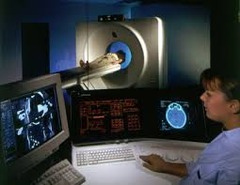
CT Scan (Computerized Tomography)

answer
- Noninvasive - Accurate test - Small levels of radiation - Views Bone, soft tissue, and blood vessels AT ONCE.
question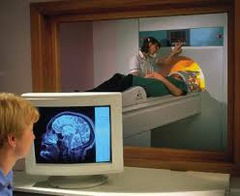
MRI (Magnetic Resonance Imaging)

answer
- Noninvasive - Soft Tissue - NO RADIATION - Less likely to cause allergic reactions
question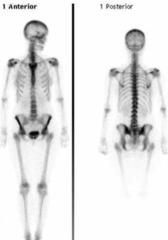
Bone Scan

answer
- Noninvasive - Does not determine cause - small radiation exposure
question
After comparing the results, which 2 genes would be of most interest to do further studies on for osteosarcoma? What about their results made you select them?
answer
These genes should be further looked at in the study of smoking and lung cancer... Gene 1: 8 Gene 5: 2 (Gene 6): 0.5 Because they are farther than 1 or 0
question
What does the mixed colors in gene 2 mean? The clear on gene 4?
answer
Gene 2: is mixed because both cells expressed the gene Gene 4: is clear because neither of the cells expressed the gene
question
What is each dot on a microarray tray represent? If a dot shows up green what does that mean?
answer
Each dot on a microarray resembles one gene (there may be multiple copies) If a dot shows up green it means that the healthy cell is expressed, but if it is a cancerous cell it means that it is not expressed.
question
When observing normal vs cancer cells under magnification, what were some characteristics you noticed?
answer
Healthy cells are round and similar Cancer cells are rigid
question
What is it called when cancer starts to spread beyond its point of origin? How does it happen?
answer
Metastasis: When tumor cells break off and find their way into the bloodstream, where they may or may not die. If they survive they find a suitable environment and begin division again. This is what allows a cancer to spread to a second point.
question
What is the difference between proto-oncogenes and tumor suppressor genes?
answer
Proto-oncogenes signal for regular cell division (mitosis) Tumor suppressor genes signal for the stop of cellular division once the cells fill the gap. When these 2 genes are mutated they are unable to stop the division so a mass of cells grow.
question
Cancer is formed when a cell starts to divide out of control and form a mass, which organelle would this division come from? Think back to biology!
answer
Mutations occur on the chromosomes that are in the nucleus.
question
Why is it necessary to have so many different types of diagnostic technology for cancer?
answer
Cancer varies by case and may be located in various tissues; bone, connective, or organ. Because it stems from so many places, one needs different machines to identify where the tumors are. Also the size of the tumor will affect how much radiology the patient receives.
question
Why is it important to know risk factors, patterns and trends of cancer?
answer
So one can be aware of any familial, symptoms, concerns, or risks that may contribute to a higher likelihood of developing cancer.
question
What happens when normal cells have a mutation?
answer
Normal cells grow and divide in an organized manner through the cell cycle: DNA synthesis, preparation for Mitosis, Prophase, Metaphase, Anaphase, Telophase. This cycle is regulated by several proteins in order to ensure that cells only divide when they are signaled to do so. Mutations in proto-oncogenes or tumor suppressor genes allow for a cancerous cell to go through cellular division without any restrictions. These cells may grow and divide without the control of the cell cycle because the genes are either "turned on" (oncogenes) or "turned off" (tumor suppressor). When cells have a mutation in the proto-oncogenes, those genes become oncogenes, genes that produce a different protein and interferes with normal cell division. These cells no longer regulate cell growth which causes them to grow uncontrollably and possibly form tumors. When tumor suppressor genes are turned off, they are unable to signal a cell to stop mitosis, as well as for the cell to complete apoptosis: a controlled part of a cell's development in which it dies, "cell suicide." Since these cells no longer follow instruction, they are able to do and go wherever they choose. These cancerous (uncontrollably dividing) cells may start a tumor in one area of the body, but if some of the cells break off and enter blood vessels, they are able to spread throughout the body. Although the cells can die in the circulatory system due to white blood cells, bumping into walls, or death from inability to survive in blood stream, some survive and once they find a suitable environment, will divide again. Resulting in metastasis, or the development of a tumor at a separate site away from the primary tumor.
question
genomic profile
answer
see if cancer was caused by mutations in tumor suppressor genes or proto-oncogenes
question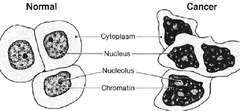
normal vs cancer cell

answer
Cancer is irregularly shaped, large nucleus, small cytoplasm, variation in cell size, loss of special features, disorganized, and have poorly defined boundaries.
question
What is the difference between normal cell division and cancer cell division?
answer
The DNA is altered and the cancer cell is defective so it will not divide only when it gets a signal from the nucleus; they divide regardless, without the signal to start and stop (regular cells need the signal to start/stop).
question
proto-oncogenes
answer
genes that normally help cells grow
question
What happens when proto-oncogenes are mutated?
answer
They become oncognes, cells that are always "turned on" and never stop the process of cellular division (cancerous).
question
tumor suppressor genes
answer
genes that slow down cellular division, repair, DNA mistakes, and tells a cell to die (apoptosis).
question
What happens when a tumor suppressor gene is mutated?
answer
the gene does not work properly and is "turned off" leading to cells growing out of control (cancerous).
question
metastasize
answer
a process in which cancer cells break off the original tumor and travel throughout the body and create tumors elsewhere.
question
How does metastasize work?
answer
The cancer cells force their way into blood vessesl and travel the bloodstream until a suitable environment comes (many die in blood from leukocytes or from bouncing into walls).
question
Point mutation

answer
change in a single nucleotide (deletion or change in one chromosome)
question
amplification
answer
when a gene is repeated more than once, so the job is carried out from multiple chromosomes.
question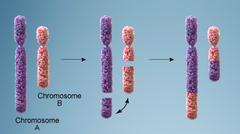
translocation

answer
proto-oncogenes are rearranged; one chromosome is stuck to another with a promoter region from another chromosome---resulting combination may cause a constant stream of growth signals.
question
How does p53 prevent cancer from forming?
answer
The protein binds to DNA and activates the transcription of protein p21 (blocks activity of cyclin-dependent kinase). This blockage allows time for the cell to repair DNA before it is replicated. If the damage is too great, the p53 signals apoptosis.
question
How many mutations does it take in order for a tumor suppressor gene to make a cell cancerous?
answer
2; whether one be damaged from birth or not.
question
How many mutations does it take in order for a proto-oncogene gene to make a cell cancerous?
answer
1 mutation from either parent cell
question
Why are tissue samples from healthy and cancer cells taken from the same patient?
answer
If everything was as constant as possible, they would know that their findings are accurate. The cells will have the exact same genetic blueprint.
question
where is mRNA found?
answer
on the poly-a-tail of RNA; it is the only one people focus on because it reflects a gene's expression (turned on or off)
question
Why is it necessary to make a cDNA copy?
answer
The fluorescent label incorporated into cDNA enables one to visualize the cDNA later on. DNA is also more stable than RNA.
question
Hybridization
answer
DNA strands, even if not originally paired togheter, will find a base pair and reform a double-stranded DNA molecule.
question
What happens once you apply the DNA from the two samples to the DNA microarray?
answer
The DNA form piles of single stranded DNA molecules. Each spot on the micorarray represents a different gene.
question
What does the red color indicate?
answer
Cancer cell RNA; in the microarray it means that more mRNA from cancer cells were "turned on" than the healthy cells.
question
What does the green color indicate?
answer
Healthy cell RNA; the microarray means that the cancer cells were more "turned off."
question
What does the yellow color indicate?
answer
Both cells express a gene (the gene is unaffected once mutated).
question
What can microarrays be used for?
answer
It can be used to identify which genes are expressed differently between two cells (usually cancerous and non-cancerous)
question
What limitations of DNA microarray technology is there?
answer
It cannot tell which genes "went bad," cannot cure a disease, and cannot identify every gene that misbehaved.
question
What is a screening tequnique for cancer?
answer
Pap test allows cells from the uterus to be placed under a microscope to help early diagnosis of cervical cancer.
question
hyperplasia
answer
tissue growth based on an excessive rate of cellular division, leading to a larger amount of cells. (callus)
question
Cancer is the ___ leading cause of death in the United States.
answer
2nd (heart disease is the 1st)
question
Risk factors
answer
cor-relational and not causal Age, Alcohol, Cancer-Causing Substances, Chronic Inflammation, Diet, Hormones, Immunosuppression, Infectious Agents, Obesity, Radiation, Sunlight, Tobacco
question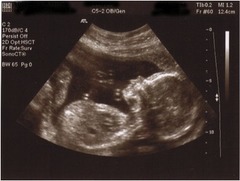
ultrasonography

answer
a diagnostic imaging technique involving the formation of a 2D image.
question
Radiology
answer
The branch of medicine that is involved with diagnostic imaging.
question
DNA replication
answer
When a cell makes a copy of its DNA before cellular division; forming 2 daughter cells.
question
apoptosis
answer
cell death due to an irreparable damage to a cell's DNA.
question
What regulates the cell cycle?
answer
oncogenes and tumor suppressor genes
question
What do all cancers express?
answer
An alteration in one or more of the oncogenes or tumor suppressor genes.
question
biobsy
answer
A procedure performed to remove tissue or cells from the body for examination under a microscope.
question
Cell culture
answer
Indicates the growing of cells outside the body.
question
in vitro
answer
outside the body
question
contact inhibition
answer
When cells stop replicating once they have close proximity with other cells.
question
replication senescence
answer
Normal cells have a limited number of cell divisions before it dies.
question
HeLa cells
answer
The first human cell line successfully growth in a laboratory (derived from cancer cells).
question
How many genes do humans have?
answer
20,000 to 25,000
question
DNA micro-arrays allow molecular biologists to...
answer
look at thousands of genes at once.
question
What do DNA micro-arrays measure?
answer
mRNA for every gene present in a cell sample so that scientists can determine what is turned off and on.
question
How are DNA micro-arrays made?
answer
1. Scientists design primer pairs so the PCR makes copies of every gene. 2. Separate the double-stranded DNA from each gene copy and place microscopic droplets of each single-stranded DNA in row on a plastic slide. 3. The results are looked at.
question
If the ratio of a micro-array is 0 then...
answer
the gene is not expressed in either cell.
question
When the ratio of a micro-array is equal to 1...
answer
gene is not affected by the tumor; gene transcription is the same in normal and cancer cells.
question
When the ratio is less than one...
answer
the gene is suppressed by tumor formation; less active in cancer cells than regular.
question
When the ratio is greater than one...
answer
the gene is induced by tumor formation; more active in cancer cell than regular.
question
What is the Pearson Correlation Coefficient?
answer
A method to calculate the similarities between individual genes by measuring how the gene expressions levels of two genes go up and down together.
question
What is the most common type of cancer in the US?
answer
Skin cancer (1,000,000 a year)
question
What effect do UV rays have on the skin? And how does the body respond?
answer
UV rays cause mutation in the DNA of the skin and can cause a cell to become cancerous or die. The body then has repair enzymes to fix the damage, however the more someone is exposed to UV, the greater the chance a mutation will occur.
question
How does sunscreen protect the skin?
answer
Sunscreen filters/blocks dangerous UV rays from the sun which prevents the UV rays from damaging the DNA.
question
What are Acidic Keratotis (AK) lesions?
answer
Small, scaly patches of precancerous skin cells on the epidermis. When left untreated, AK may turn into a squamous cell carcinoma.
question
What is 5-FU? How was it discovered?
answer
1954, some Russian guys did research on liver cells and found that cancer liver cells absorbed the radiation more readily.
question
Hereditary
answer
......... Affected both males and females and has a family history.
question
Marker Analysis
answer
a technique where the gene mutation is analyzed using a genetic marker instead of analyzing the gene itself.
question
Genetic Marker
answer
a short sequence of DNA associated with a particular gene or trait with a known location on a chromosome.
question
__________ is the genetic marker used in marker analysis.
answer
Short Tandem Repeats, or STRs are regions of DNA composed of a short sequence of nucleotides repeated many times.
question
What does the alternate forms of repeated STR correspond with?
answer
Different alleles.
question
Where is the BRCA2 mutation gene found on a chromosome?
answer
Chromosome 13,
question
How does the gel electrophorsesis separate the alleles?
answer
Based on the number of repeats present.
question
cryosurgery
answer
A procedure that uses the extreme cold produced by liquid nitrogen or argon gas to destroy the abnormal tissue.
question
Virus
answer
Non-living particles which contain DNA or RNA surrounded by a protein capsid; they attach themselves to a host cell and insert their genetic material into the cell, causing a mutation to form.
question
How can a virus be linked to cancer?
answer
The virus inserts its DNA or RNA into the host cell causing a mutation to form, which if to a proto-oncogene or a tumor suppressor gene, could cause cancer.
question
Virologist
answer
A scientist who studies viruses and look up new drugs to cure these infections and to prevent them from developing.
question
How does 5-FU work?
answer
The cancer medication is an pyrimidine analog that is a chemotherapy drug that stops cancer cells from working properly by enabling them to repair their DNA (cancer cells need DNA to grow and multiply). 5-fluorouracil targets thymine, one of the DNA bases in order to stop the process of DNA or RNA replication; causing the cell to die.
question
What is the normal function of BRCA1 and BRCA2?
answer
These genes are tumor suppressors.
question
If one has an abnormality in their BRCA1 or BRCA2 gene does that mean they have breast cancer?
answer
No, it just increases their risk to 85%.
question
What is the difference between marker analysis and the typical gel electrophoresis method?
answer
Marker analysis is a technique that allows for a gene mutation to be analyzed by using a genetic marker instead of analyzing the gene itself. A genetic marker is a short sequence of DNA associated with a particular gene with a known location on the chromosome.
question
What genetic material does a DNA micro-array measure? What do the colors mean?
answer
A DNA micro-array measures the mRNA and the color red means more expressed by cancer, green is less expressed by cancer, yellow is equally expressed by both cancer and healthy cells, and clear is expressed by neither.
question
What is the difference between biological and genetic risk factors?
answer
Biological risk factors are the phsyical traits; race/age/gender. Genetic risk factors are passed down in families through genes; the BRCA2 gene is a risk factor for breast cancer.
question
What is the ABCD tests for melanoma?
answer
A: Asymmetrical Shape (not symmetrical) B: Border (irregular) C: Color (abnormal) D: Diameter (too big) E: Evolving



